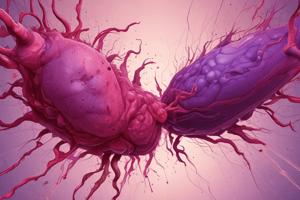Podcast
Questions and Answers
What is inferred when a patient presents with bleeding but no anatomical cause can be discovered?
What is inferred when a patient presents with bleeding but no anatomical cause can be discovered?
- Primary coagulation factor deficiency
- Functional impairment of the normal hemostatic process (correct)
- Excessive platelet activation
- Structural abnormalities in blood vessels
Which disorder is characterized by frequent bleeding episodes primarily from the nose and gastrointestinal tract?
Which disorder is characterized by frequent bleeding episodes primarily from the nose and gastrointestinal tract?
- Hereditary hemorrhagic telangiectasia (correct)
- Steroid purpura
- Henoch-Schonlein syndrome
- Ehlers-Danlos syndrome
What is the typical presentation of hemarthrosis?
What is the typical presentation of hemarthrosis?
- Bleeding in the joints (correct)
- Petechiae all over the body
- Intracranial hemorrhage
- Characteristic skin bruising
Which condition is associated with abnormal telangiectatic capillaries resulting in bleeding episodes?
Which condition is associated with abnormal telangiectatic capillaries resulting in bleeding episodes?
In what percentage of cases do individuals with hereditary hemorrhagic telangiectasia develop pulmonary AVM?
In what percentage of cases do individuals with hereditary hemorrhagic telangiectasia develop pulmonary AVM?
At what age, on average, does epistaxis (nosebleeds) begin in individuals with hereditary hemorrhagic telangiectasia?
At what age, on average, does epistaxis (nosebleeds) begin in individuals with hereditary hemorrhagic telangiectasia?
Which condition is characterized by the need for vitamin C to synthesize hydroxyproline, an essential constituent of collagen?
Which condition is characterized by the need for vitamin C to synthesize hydroxyproline, an essential constituent of collagen?
Which condition is associated with (+) acute inflammatory reaction with IgA and complement components in capillaries, mesangial tissues, and small arterioles?
Which condition is associated with (+) acute inflammatory reaction with IgA and complement components in capillaries, mesangial tissues, and small arterioles?
In which condition can glucocorticoid therapy lead to skin bleeding and easy bruising due to atrophy of supporting connective tissue?
In which condition can glucocorticoid therapy lead to skin bleeding and easy bruising due to atrophy of supporting connective tissue?
Which disorder involves a platelet count lower than 150,000?
Which disorder involves a platelet count lower than 150,000?
What symptom typically precedes Henoch-Schönlein purpura?
What symptom typically precedes Henoch-Schönlein purpura?
Which condition involves vasculitis and increased vascular permeability leading to localized hemorrhage?
Which condition involves vasculitis and increased vascular permeability leading to localized hemorrhage?
What is the most common non-iatrogenic cause of thrombocytopenia?
What is the most common non-iatrogenic cause of thrombocytopenia?
What is a key step in evaluating a patient with thrombocytopenia?
What is a key step in evaluating a patient with thrombocytopenia?
What is the role of calcium content in causing pseudothrombocytopenia?
What is the role of calcium content in causing pseudothrombocytopenia?
When should a bone marrow examination be recommended in the evaluation of thrombocytopenia?
When should a bone marrow examination be recommended in the evaluation of thrombocytopenia?
What is the fundamental defect in Glanzmann's thrombasthenia?
What is the fundamental defect in Glanzmann's thrombasthenia?
Which condition presents with bleeding in skin, mucous membrane, recurrent epistaxis, and GI hemorrhage?
Which condition presents with bleeding in skin, mucous membrane, recurrent epistaxis, and GI hemorrhage?
What therapy is successful in refractory or relapsing TTP?
What therapy is successful in refractory or relapsing TTP?
Which condition is almost always due to iron deficiency, inflammation, cancer, or infection?
Which condition is almost always due to iron deficiency, inflammation, cancer, or infection?
What is the main reason for initiating plasma exchange in TTP?
What is the main reason for initiating plasma exchange in TTP?
Which therapy should only be used as an adjunct to plasma exchange in TTP?
Which therapy should only be used as an adjunct to plasma exchange in TTP?
What is a common characteristic of Drug-Induced Thrombocytopenia?
What is a common characteristic of Drug-Induced Thrombocytopenia?
Which drug may cause thrombocytopenia within 24 hours of initial exposure?
Which drug may cause thrombocytopenia within 24 hours of initial exposure?
How long after the initial exposure to classic drug-dependent antibodies does thrombocytopenia typically occur?
How long after the initial exposure to classic drug-dependent antibodies does thrombocytopenia typically occur?
What is a distinguishing feature of the thrombocytopenia caused by platelet GpIIbIIIa inhibitory drugs like abciximab?
What is a distinguishing feature of the thrombocytopenia caused by platelet GpIIbIIIa inhibitory drugs like abciximab?
What is a distinguishing characteristic of Heparin-Induced Thrombocytopenia?
What is a distinguishing characteristic of Heparin-Induced Thrombocytopenia?
Why should all drugs be suspected in a patient with thrombocytopenia without an apparent cause?
Why should all drugs be suspected in a patient with thrombocytopenia without an apparent cause?
Flashcards
Bleeding Without Anatomical Cause
Bleeding Without Anatomical Cause
A functional impairment of the normal hemostatic process is inferred when a patient has bleeding but no anatomical cause can be identified.
Hereditary Hemorrhagic Telangiectasia
Hereditary Hemorrhagic Telangiectasia
Hereditary hemorrhagic telangiectasia, a disorder characterized by frequent bleeding episodes, typically affects the nose and gastrointestinal tract.
Hemarthrosis
Hemarthrosis
Hemarthrosis, characterized by bleeding in the joints, is a common consequence of various conditions.
Abnormal Telangiectatic Capillaries
Abnormal Telangiectatic Capillaries
Signup and view all the flashcards
Pulmonary AVM in HT
Pulmonary AVM in HT
Signup and view all the flashcards
Epistaxis in HT
Epistaxis in HT
Signup and view all the flashcards
Scurvy: Vitamin C Deficiency
Scurvy: Vitamin C Deficiency
Signup and view all the flashcards
Henoch-Schönlein Purpura: Inflammatory Reaction
Henoch-Schönlein Purpura: Inflammatory Reaction
Signup and view all the flashcards
Glucocorticoid Therapy in Scurvy
Glucocorticoid Therapy in Scurvy
Signup and view all the flashcards
Quantitative Disorders: Low Platelet Count
Quantitative Disorders: Low Platelet Count
Signup and view all the flashcards
HSP: Preceding Inflammatory Reaction
HSP: Preceding Inflammatory Reaction
Signup and view all the flashcards
Cushing's Syndrome: Vasculitis and Bleeding
Cushing's Syndrome: Vasculitis and Bleeding
Signup and view all the flashcards
Infection-Induced Thrombocytopenia
Infection-Induced Thrombocytopenia
Signup and view all the flashcards
Peripheral Blood Smear in Thrombocytopenia
Peripheral Blood Smear in Thrombocytopenia
Signup and view all the flashcards
Pseudothrombocytopenia: High Calcium Trigger
Pseudothrombocytopenia: High Calcium Trigger
Signup and view all the flashcards
Bone Marrow Examination in Thrombocytopenia
Bone Marrow Examination in Thrombocytopenia
Signup and view all the flashcards
Glanzmann's Thrombasthenia: GpIIbIIIa Receptor Defect
Glanzmann's Thrombasthenia: GpIIbIIIa Receptor Defect
Signup and view all the flashcards
Glanzmann's Thrombasthenia: Bleeding Symptoms
Glanzmann's Thrombasthenia: Bleeding Symptoms
Signup and view all the flashcards
Rituximab for Refractory TTP
Rituximab for Refractory TTP
Signup and view all the flashcards
Reactive Thrombocytosis: Underlying Causes
Reactive Thrombocytosis: Underlying Causes
Signup and view all the flashcards
Plasma Exchange in TTP
Plasma Exchange in TTP
Signup and view all the flashcards
Glucocorticoids in TTP
Glucocorticoids in TTP
Signup and view all the flashcards
Drug-Induced Thrombocytopenia: Any Drug
Drug-Induced Thrombocytopenia: Any Drug
Signup and view all the flashcards
Abciximab: Rapid Thrombocytopenia
Abciximab: Rapid Thrombocytopenia
Signup and view all the flashcards
Classic Drug-Dependent Antibodies: 21-Day Delay
Classic Drug-Dependent Antibodies: 21-Day Delay
Signup and view all the flashcards
GpIIbIIIa Inhibitory Drugs: Rapid Effect
GpIIbIIIa Inhibitory Drugs: Rapid Effect
Signup and view all the flashcards
Heparin-Induced Thrombocytopenia (HIT)
Heparin-Induced Thrombocytopenia (HIT)
Signup and view all the flashcards
Drugs as Potential Culprits
Drugs as Potential Culprits
Signup and view all the flashcards




